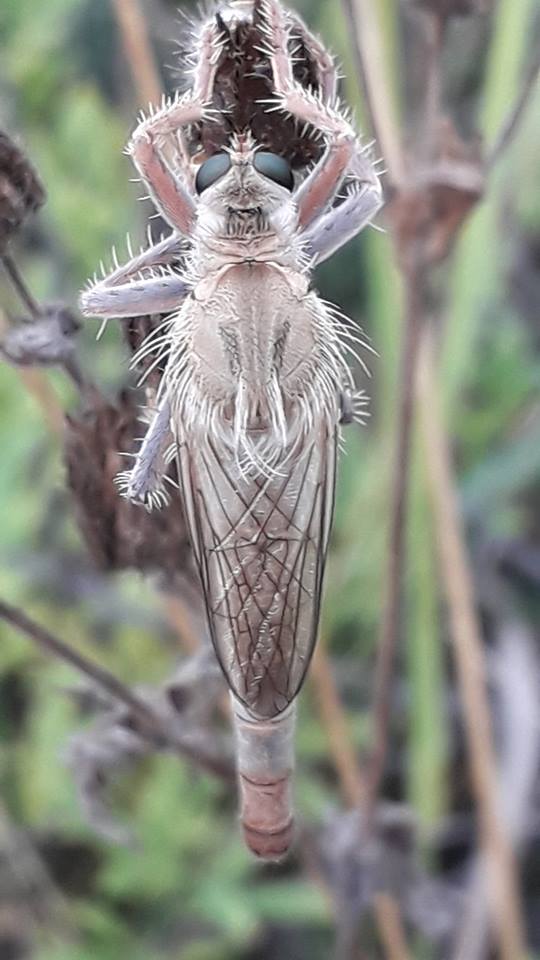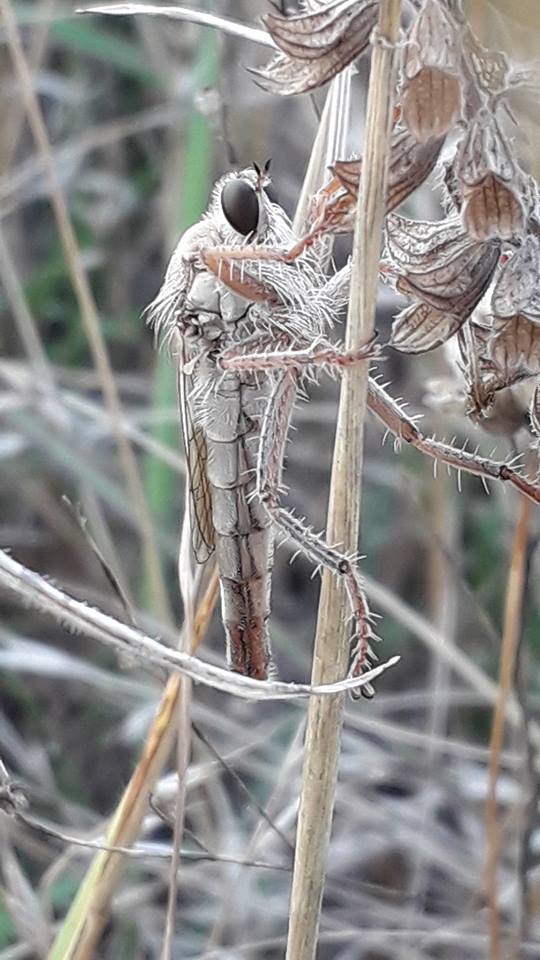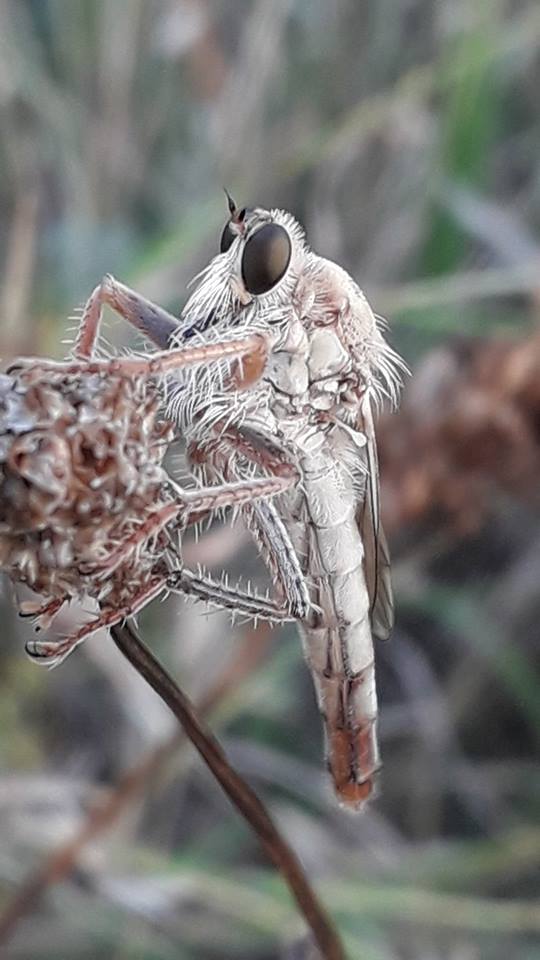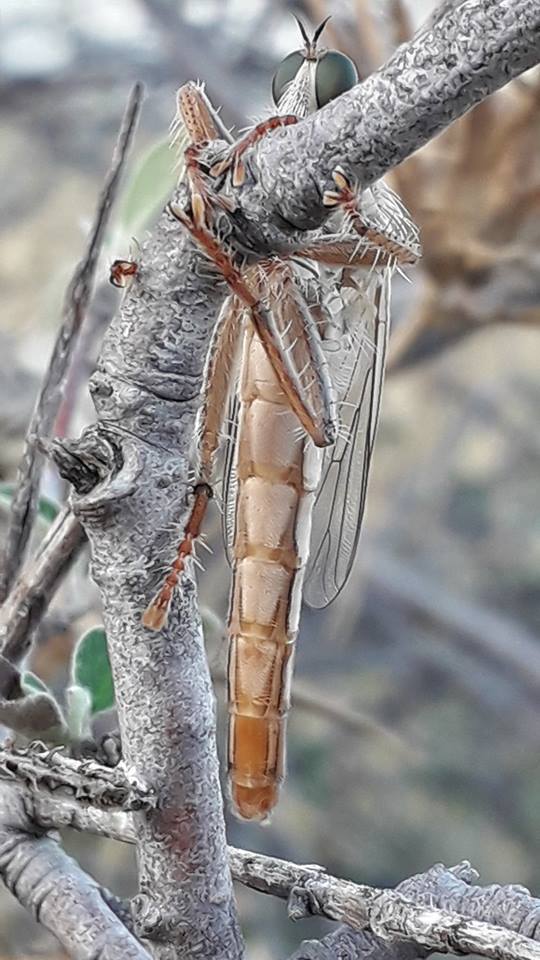Diptera.info :: Family forums :: Asilidae Forum
|
Stenopogon sp.
|
|
| Armen Seropian |
Posted on 22-07-2018 21:10
|
|
Member Location: Georgia, Tbilisi Posts: 391 Joined: 21.03.16 |
I will be greatfull for any help in determination fo this Stenopogon sp. from Georgia (Gori), 23.VII.2018
Armen Seropian attached the following image:  [58.52Kb] |
|
|
|
| Armen Seropian |
Posted on 22-07-2018 21:10
|
|
Member Location: Georgia, Tbilisi Posts: 391 Joined: 21.03.16 |
Lateral view
Armen Seropian attached the following image:  [74.41Kb] |
|
|
|
| Armen Seropian |
Posted on 22-07-2018 21:12
|
|
Member Location: Georgia, Tbilisi Posts: 391 Joined: 21.03.16 |
Face
Armen Seropian attached the following image:  [65.49Kb] |
|
|
|
| Quaedfliegh |
Posted on 23-07-2018 13:12
|
|
Member Location: Tilburg Netherlands Posts: 2225 Joined: 18.05.10 |
I have used the key by Engel (1930) and end up with S. superbus but I think things have changed since then. When I use Lehr's key from 1963 I end up with S. avus solsolacearum. I think it is a rather confusing group of Stenopogon species and literature is not helping much for I can't read Russian.
Greetings, Reinoud Field guide to the robber flies of the Netherlands and Belgium: https://www.jeugdbondsuitgeverij.nl/product/field-guide-to-the-robberflies-of-the-netherlands-and-belgium/ https://www.nev.nl/diptera/ |
| Armen Seropian |
Posted on 23-07-2018 17:44
|
|
Member Location: Georgia, Tbilisi Posts: 391 Joined: 21.03.16 |
Hi Reinoud, Also I know russian well, the book "Asilidae of Caucasus" didn't help me a lot.  I've excluded some species and the left ones are: S. rufipilus S. sciron S. elongatus S. nataliae S. junceus S. mollis S. obliteratus S. sabaudus S. nataliae description says about reddish mesonotum. blackish abdomen densily covered with grey and golden dust, the first tergite is laterally covered with long white hair, the last 2 tergites (and all sternites) are reddish. But the description of S. elongatus seems to match quit well too. |
|
|
|
| Quaedfliegh |
Posted on 23-07-2018 23:15
|
|
Member Location: Tilburg Netherlands Posts: 2225 Joined: 18.05.10 |
The 5th radial cell in your specimen is closed and stalked so you can disregard all species of which 5th radial cell is open. (which include at least the following: elongatus, junceus, mollis and sabaudus). I could not yet find a description of Richter's nataliae and obliteratus. In my experience the color of all parts of most species is very variable in Stenopogon and a lot of discussion is still going on. Who wrote "Asilidae of Caucasus" and when was it published? Greetings, Reinoud Field guide to the robber flies of the Netherlands and Belgium: https://www.jeugdbondsuitgeverij.nl/product/field-guide-to-the-robberflies-of-the-netherlands-and-belgium/ https://www.nev.nl/diptera/ |
| Armen Seropian |
Posted on 24-07-2018 13:34
|
|
Member Location: Georgia, Tbilisi Posts: 391 Joined: 21.03.16 |
The book is written by V. A. Richter (1968). If needed, I can send it to you via e-mail. |
|
|
|
| Quaedfliegh |
Posted on 24-07-2018 15:20
|
|
Member Location: Tilburg Netherlands Posts: 2225 Joined: 18.05.10 |
Ahhh, thank you! I already have it but I can't read Russian ;-(
Greetings, Reinoud Field guide to the robber flies of the Netherlands and Belgium: https://www.jeugdbondsuitgeverij.nl/product/field-guide-to-the-robberflies-of-the-netherlands-and-belgium/ https://www.nev.nl/diptera/ |
| Armen Seropian |
Posted on 24-07-2018 15:55
|
|
Member Location: Georgia, Tbilisi Posts: 391 Joined: 21.03.16 |
OK. Then I'll try to exclude some species from the remained ones. As Richter writes, S. obliteratus sternites are covered with long yellow hair, that aren't present at the pictures (also the description is given only for males). For S. rufipilus - mesonothum black, dencily covered with yellowish/greyish dust and short yellow hair, abdomen black (the specimen on photo shows long hair on mesonothum and reddish abdomen). As for S. sciron - legs are black (legs are partially red on photo). So the only one that remains is S. nataliae?  The thing is it's nor recoreded form Georgia (Also known from neighbouring Armenia). The thing is it's nor recoreded form Georgia (Also known from neighbouring Armenia).
Edited by Armen Seropian on 24-07-2018 16:01 |
|
|
|
| Quaedfliegh |
Posted on 24-07-2018 20:02
|
|
Member Location: Tilburg Netherlands Posts: 2225 Joined: 18.05.10 |
In Engel S. superbus does not have black legs but is now regarded as subspecies of sciron. S. avus is not in your list but also know from the area. To be honest I dont have a clue and the specimen is nothing short of stunning and it also seems to be large. Could you give the description of S. nataliae?
Edited by Quaedfliegh on 24-07-2018 20:03 Greetings, Reinoud Field guide to the robber flies of the Netherlands and Belgium: https://www.jeugdbondsuitgeverij.nl/product/field-guide-to-the-robberflies-of-the-netherlands-and-belgium/ https://www.nev.nl/diptera/ |
| Armen Seropian |
Posted on 26-07-2018 18:27
|
|
Member Location: Georgia, Tbilisi Posts: 391 Joined: 21.03.16 |
I've tried to translate the description of S. nataliae. Here's what I've got: "The face yellowish-brown in yellowish-gray вгые; forehead and vertex in yellowish-gray dust; the setae and bristles along the sides of the forehead are white; facial beard of white setae and hairs under the antennae; palpus covered with white hair; whiskers and occipital setae white; two basal segments of antennae yellow, third segment yellowish-brown; the length of the arista is less than half the length of the third antennal segment. Mesonotum reddish-brown, with reddish-yellow humeral tubercles, in yellowish-gray pollen and short white hairs; setae of white pronotum; dorsoscentral setae in the number of 1-3 pairs go forward for a transverse suture; scutellum yellow or yellowish-brown; arista lengnth less than half length of the antennae third segment. Legs in dense adjoining thin white hairs and white setae; hips are red, front and back with a wide black longitudinal strip, which in front of the ribs is shortened and developed only in the basal half of the thigh; anterior tibia reddish-yellow; middle tibiae brownish-red; hind tibiae dark brown; claws black, in the main third red. Wings are transparent, slightly yellowish; The costal vein at the base of the wing is covered with dense white hairs; the fourth posterior cell at the apex is closed, stalked. Abdomen black, with yellow posterior margins of tergites, last two tergites and all sternites sometimes reddish-yellow, with gray dust and short white hair; First tergite laterally with long white bristles. Body length 19-23 mm." Armen Seropian attached the following image:  [73.42Kb] Edited by Armen Seropian on 26-07-2018 18:28 |
|
|
|
| Armen Seropian |
Posted on 26-07-2018 18:29
|
|
Member Location: Georgia, Tbilisi Posts: 391 Joined: 21.03.16 |
another pic of a different specimen that I believe to be the same species.
Armen Seropian attached the following image:  [55.28Kb] Edited by Armen Seropian on 26-07-2018 18:30 |
|
|
|
| Quaedfliegh |
Posted on 26-07-2018 19:06
|
|
Member Location: Tilburg Netherlands Posts: 2225 Joined: 18.05.10 |
Thank you very much, copied that :-) Just to be sure; is the 5th radial cell (sometimes called 1th posterior cell) mentioned somewhere in the text? Greetings, Reinoud Field guide to the robber flies of the Netherlands and Belgium: https://www.jeugdbondsuitgeverij.nl/product/field-guide-to-the-robberflies-of-the-netherlands-and-belgium/ https://www.nev.nl/diptera/ |
| Armen Seropian |
Posted on 26-07-2018 19:33
|
|
Member Location: Georgia, Tbilisi Posts: 391 Joined: 21.03.16 |
Not in the text, but in the given above the text Stenopogon key (first posterior cell closed, or closed and stalked) (1(4) in the key). Any ideas though after additional pics of ventral view and description? 
Edited by Armen Seropian on 26-07-2018 19:36 |
|
|
|
| Quaedfliegh |
Posted on 27-07-2018 00:35
|
|
Member Location: Tilburg Netherlands Posts: 2225 Joined: 18.05.10 |
The description fits rather well and it could be S. nataliae. But I have become more cautious during my study of S. junceus and all the variety in colour differences in specimens and confusing descriptions. I have no experience with the species of your area. So, in my opinion S. nataliae is a good possibility. Anyway, it is an impressive creature and the pictures are great! Maybe you should add them to the gallery as Stenopogon cf nataliae. That way we keep a form of reference.
Greetings, Reinoud Field guide to the robber flies of the Netherlands and Belgium: https://www.jeugdbondsuitgeverij.nl/product/field-guide-to-the-robberflies-of-the-netherlands-and-belgium/ https://www.nev.nl/diptera/ |
| piros |
Posted on 27-07-2018 18:04
|
|
Member Location: Szeged, Hungary Posts: 1817 Joined: 04.01.12 |
What an increadible beast! Greetings, Henrik |
|
|
|
| Armen Seropian |
Posted on 29-07-2018 19:56
|
|
Member Location: Georgia, Tbilisi Posts: 391 Joined: 21.03.16 |
Glad you've liked it! Here's a good shot of ventral side Armen Seropian attached the following image:  [80.39Kb] |
|
|
|
| Jump to Forum: |













